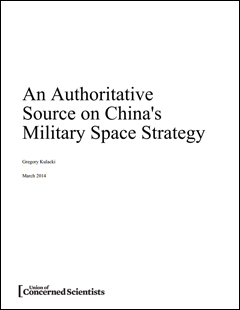China’s military strategy has long been thought of as “asymmetric,” or designed to counter much stronger adversaries. Many U.S. analysts assume this strategy includes attacking U.S. satellites with missiles (the so-called “space Pearl Harbor”). This alarming assumption took root in the late 1990s and is based on information that may be incorrect.
In fact, analysis of a classified military textbook suggests that China was not pursuing an anti-satellite space strategy at that time. Titled The Science of Second Artillery Operations, the textbook was published in 2003 by the Chinese Army (PLA), then partially translated and analyzed in 2014 by the Union of Concerned Scientists.
Reflecting more than 30 years of research and thinking by the PLA, the book suggests that China’s emerging space capabilities were seen as a valuable military asset, but not as a means of attack.
While not definitive, the textbook provides good reason to question conventional U.S. wisdom on China’s military strategies, particularly in space.




